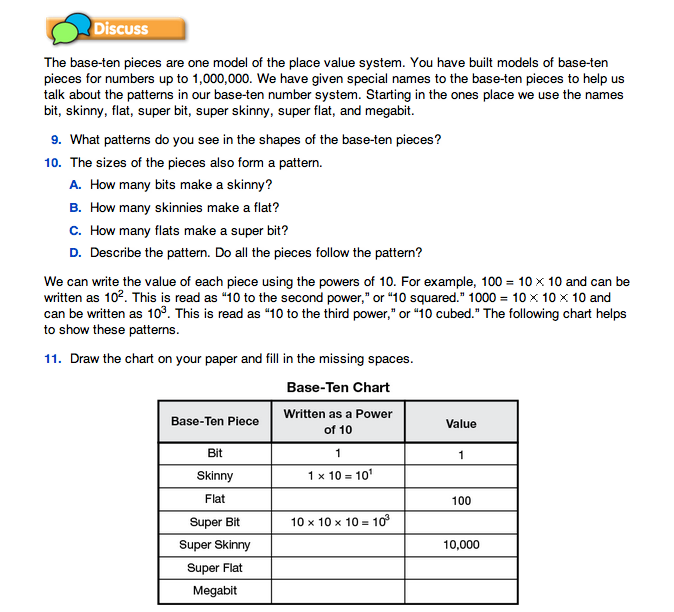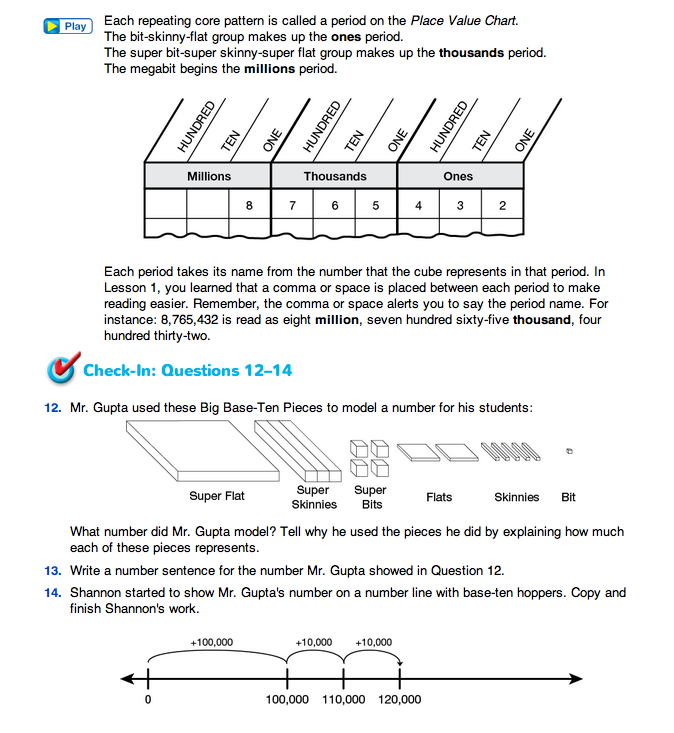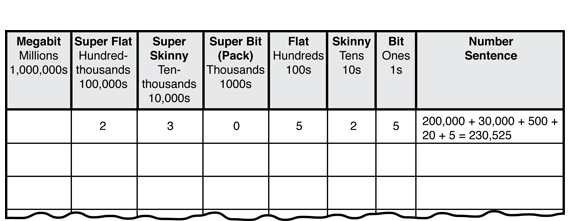Big Base-Ten Pieces
Est. Class Sessions: 3Developing the Lesson
Part 3: Patterns in the Base-Ten Pieces
Discuss Question 3 on the Big Numbers pages in the Student Activity Book. In this problem, Jackie is trying to represent 230,525 with base-ten pieces, and a pack is the largest piece available. Now that the class has constructed base-ten pieces larger than a pack, expand the Base-Ten Pieces Recording Sheet. Use a display of the Big Base-Ten Pieces Recording Sheet Master. See Figure 10.
Ask student volunteers to record 230,525 on the newly expanded base-ten recording sheet display. Ask them to show which pieces are needed to represent this number. The artwork under the Patterns in the Base-Ten Pieces section of the Big Base-Ten Pieces pages in the Student Guide may help some students visualize the pieces along with those built by the class.
Ask:
Ask students to record the partitions of a few other big numbers chosen from the Newswire on a display of the Base-Ten Pieces Recording Sheet. Master.
Read the thoughts of the little mouse from the artwork under the Patterns in the Base-Ten Pieces section in the Student Guide.
Discuss why the mouse prefers a megabit to the other models. Refer to your models as you discuss the patterns in the shapes and sizes of the pieces. Question 9 asks students to describe the patterns they see in the shapes. Beginning with the bit, the shapes repeat: bit, skinny, flat, bit, skinny, flat, bit.
Question 10 asks students to look for a pattern in the sizes of the pieces. Beginning at the right of the illustration: the skinny is ten times as large as a bit, the flat is ten times as large as a skinny (Questions 10A–B), and the super bit is ten times as large as a flat (Question 10C). Be sure students see that this pattern continues with all the pieces. Each piece is ten times as large as the piece to its right (Question 10D).
Introduce the use of exponents to write the value of each base-ten piece. Explain that each column on the place value chart can be written as a power of 10. For example 10 is equal to 101, 100 is equal to 10 × 10 or 102,and 1000 is equal to 10 × 10 × 10 or 103. Have students copy the chart in the Student Guide onto their own paper and use it to help them organize this information (Question 11). Students may question why 1 is not written as a power of 10. If this question comes up, ask the students what power of 10 might equal 1. It is possible that a student will continue the pattern in the exponents from the chart and suggest that this is 100. If this is suggested, you can add this to the Base-Ten Chart.
Connect the information in the Base-Ten Chart in Question 11 with the information in Place Value Chart II. Discuss the division of the chart into periods. Each period is named after the cube or bit. We usually divide periods with a comma or a space when we write numbers.
Assign Check-In: Questions 12–14 in the Student Guide to connect the place value representations in this lesson.
















